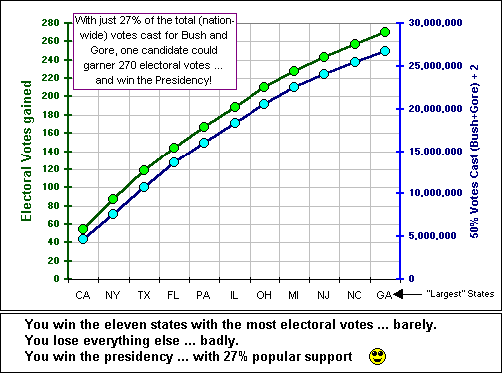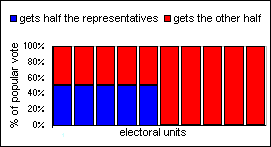| an Electoral Scenario: comments on the U.S. electoral college system (and other democratic systems) |
Here's an interesting chart, pertaining to the year 2000 U.S. elections:

What it says is this:
| If, for the eleven states with the most electoral votes, one candidate received a slim majority (of the votes cast for Bush + Gore), namely 2 greater than 50% of the Bush+Gore Total, that candidate would win the 270 electoral votes necessary to become president ... and that would be only 27% of the total (nation-wide) number of votes cast for Bush+Gore! |
>Huh? 27%? You're kidding, right?
That got me to thinking of a better way which would give the position of head-of-state to the candidate with the most votes (not just 27%).
Here goes:
- Assume that the total number of people (nation-wide) that can vote is P
(example: P = 100,000,000 voters in the country) - We divide the country into N equally populated electoral units each with a prospective government repesentative
(ex: N = 200 units ... so 200 elected officials - one from each unit) - Each unit has precisely P/N people that can vote
(ex: P/N = 500,000 voters per unit. They elect the local government representative.) - The party with the greatest number of elected officials forms the new government.
- Assume that, in precisely half of the N units (ex: that's N/2 = 100 units),
Sally's party receives 1 greater than 50% of these P/N votes.
Then Sally receives (1/2)(P/N) + 1 votes for her party.
(ex: 250,001 votes in each of N/2 = 100 units) - This slim majority gives Sally's party the government representative from that unit.
This plurality in half the electoral units then gives Sally half of the N representatives, namely N/2
(ex: N/2 = elected 100 reps) - The total number of votes received by Sally in the N/2 electoral units (where she won
by the slim majority) is
(Number of Units)(Votes per Unit) = (N/2){(1/2)(P/N)+1} = P/4 + N/2
ex: (100 units)(250,001 votes/unit) = 25,000,100 votes - To get the percentage of the total available votes (total votes = P) we divide by P and get
1/4 + N/2P.
ex: (25,000,100)/(100,000,000) = .250001 or 25.0001%
>Who's Sally?
She's the leader of the party. If her party wins more reps than any other party, she becomes head of state.
In general, since N is usually small compared to P - the elected representives are a small fraction of the voting populace - then N/2P is small compared to 1/4, so we conclude (surprise!) that one candidate can win half of the representives with little more than 1/4 or 25% of the popular votes.
|
>Picture?
Yeah, maybe a picture is worth ... uh, a thousand votes. >That's your "better" system?
|  |
Let's not scoff at:
27% of the popular vote can win the presidency!
It could happen (almost) anywhere ... DEMOCRATICALLY SPEAKING 
